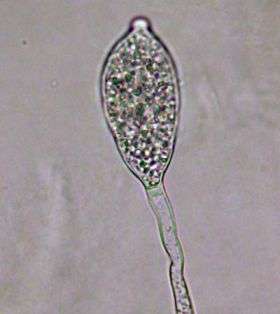Scientists to study high-risk plant pathogen using small, unmanned aircraft

A Virginia Tech plant pathologist known for his investigation of microbial life in the lower atmosphere is using unmanned aerial vehicles (UAVs) in a new, three-year study to detect, monitor, and forecast the spread of a fungus-like organism responsible for the Irish Potato Famine in the 1840s and 1850s. This famine resulted in the deaths of more than 1 million people in Ireland and caused at least 1.5 million more to flee the country.
David Schmale, assistant professor of plant pathology, physiology, and weed science in the College of Agriculture and Life Sciences, hopes a recent grant of nearly $1 million from the U.S. Department of Agriculture (USDA) will help scientists better understand how Phytophthora infestans, a high-risk plant pathogen that causes late blight of potato and tomato, is transported through the atmosphere. Other researchers on this project are Elson Shields, professor of entomology at Cornell University, and Donald Aylor, distinguished scientist at the Connecticut Agricultural Experiment Station.
“Today, over 150 years after the Irish Potato Famine, P. infestans is still a major problem and a potential biosecurity threat,” said Schmale, who pointed out that Virginia’s last major outbreak of P. infestans was along the Eastern Shore in 1996. “Currently, there are no commercial varieties of potato that are completely resistant to the pathogen. The ability to track the movement of P. infestans in the atmosphere may assist in making rational and informed management decisions.”
Schmale has added six new hobby-size planes to his “air force” of nine UAVs. With the help of the Virginia Center for Autonomous Systems, a Virginia Tech research center that facilitates collaboration in autonomous systems technologies, he has retrofitted these small aircraft with unique collection plates that open while the plane is in flight above potato fields at Virginia Tech’s Kentland Farm. The UAVs can collect samples of P. infestans tens to hundreds of meters above agricultural fields.
Schmale purchased state-of-the-art equipment that will enable him to detect and quantify P. infestans at the Kentland Farm within a matter of minutes following sample collection. Schmale and colleagues are using this data to generate a long-distance transport model for P. infestans, which may be integrated into a 3-D map viewable in Google Earth.
“This research will allow scientists to know where this pathogen could move and what strategies we could use to mitigate it if an epidemic occurs,” Schmale said. “One outcome of this project will be the development of an online resource that provides growers and producers with rapid forecasting of the potential spread of late blight so they can take appropriate measures to safeguard their crops.”
The USDA grant also provides funding for a new undergraduate course in the Department of Plant Pathology, �鶹��Ժiology, and Weed Science on “aerobiology” – the study of how organisms are transported in the atmosphere. The course, which begins in the third year of the grant, will be the first of its kind at Virginia Tech and will involve students participating in hands-on projects in aerobiology, biosecurity, and environmental science.
Source: Virginia Tech



















